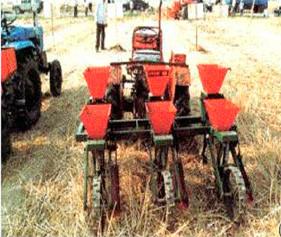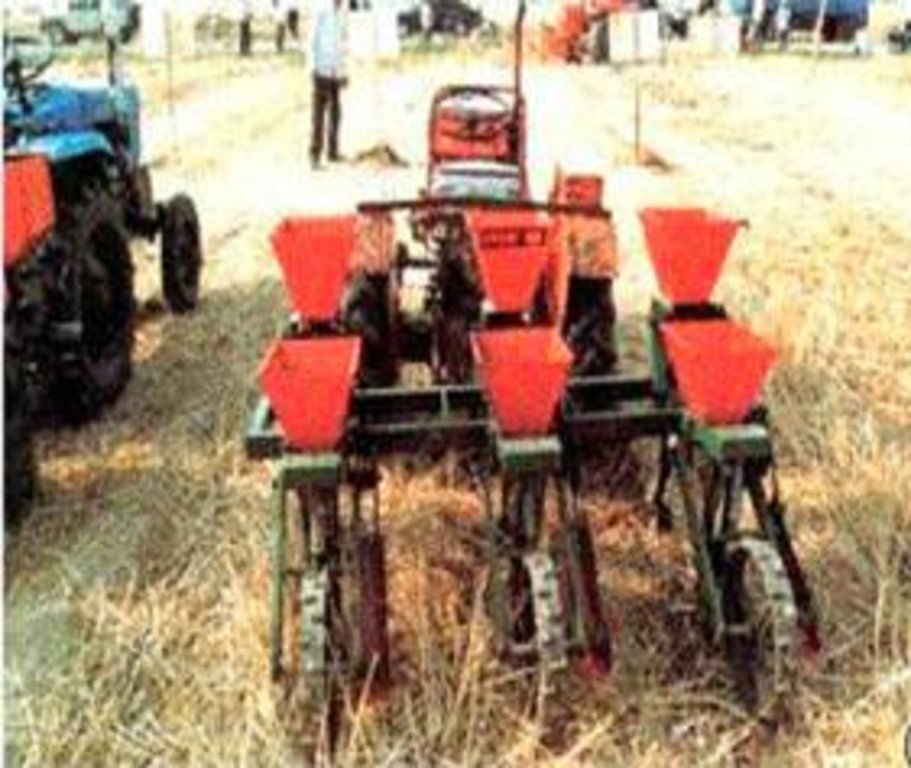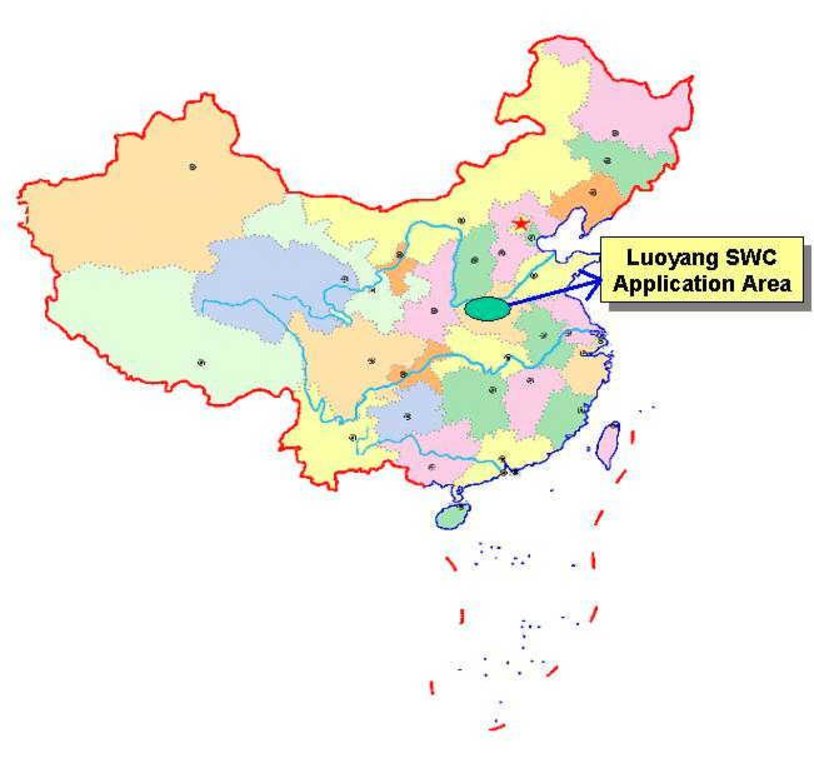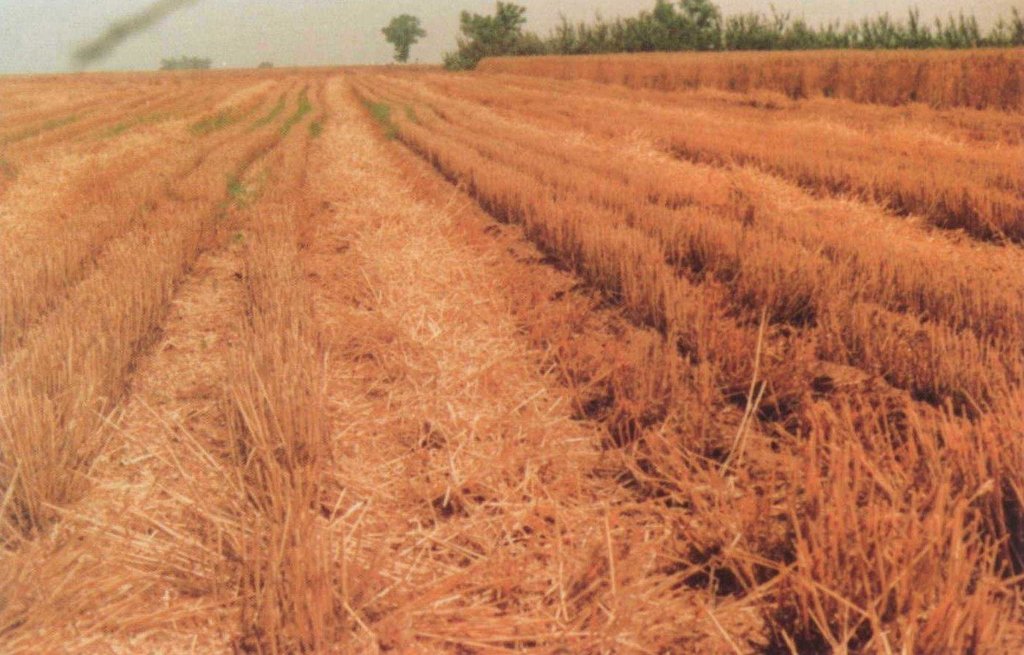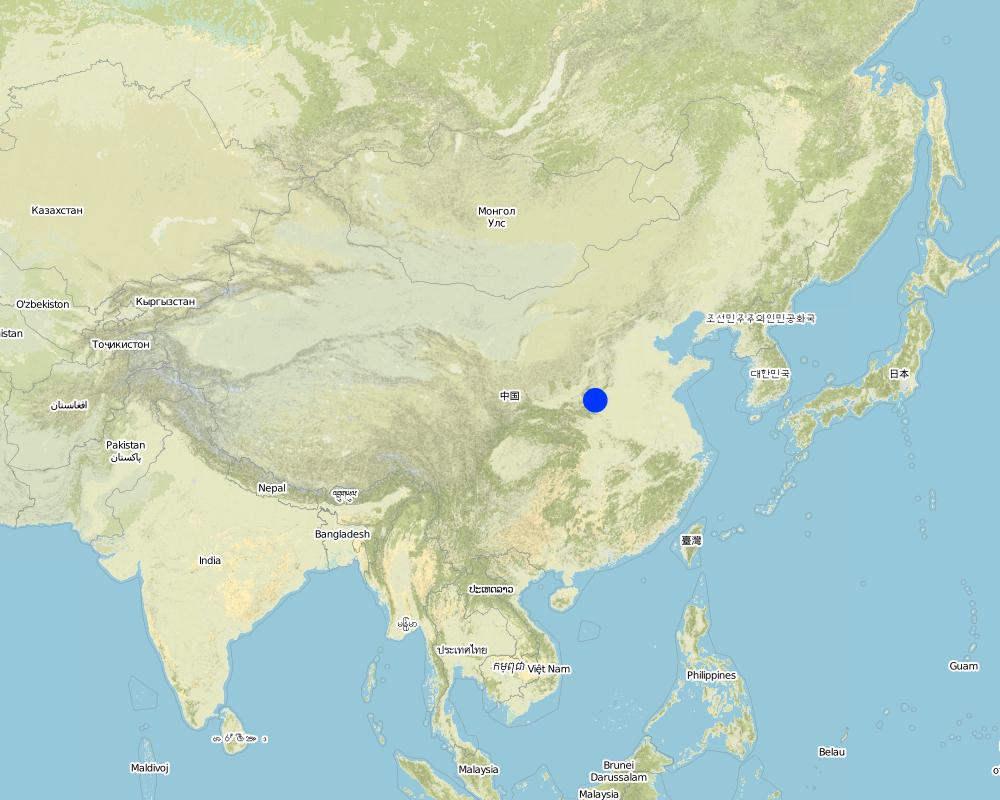Zero Tillage [จีน]
- ผู้สร้างสรรค์:
- การอัพเดท:
- ผู้รวบรวม: Zhanguo Bai
- ผู้เรียบเรียง: –
- ผู้ตรวจสอบ: Laura Ebneter
approaches_2411 - จีน
ดูส่วนย่อย
ขยายทั้งหมด ย่อทั้งหมด1. ข้อมูลทั่วไป
1.2 รายละเอียดที่ติดต่อได้ของผู้รวบรวมและองค์กรที่เกี่ยวข้องในการประเมินและการจัดเตรียมทำเอกสารของแนวทาง
ผู้เชี่ยวชาญ SLM:
Wang Deshui
(8610) 68918672
Institute of Soil & Fertilizer, Chinese Academy of Agricultural Sciences (CAAS)
12 zhong guan cun south street, Beijing 100081, P.R. of China
จีน
ชื่อของโครงการซึ่งอำนวยความสะดวกในการทำเอกสารหรือการประเมินแนวทาง (ถ้าเกี่ยวข้อง)
Institute of Agricultural Resources and Regional Planning of Chinese Academy of Agricultural Sciences (CAAS) - จีน1.3 เงื่อนไขที่เกี่ยวข้องกับการใช้ข้อมูลที่ได้บันทึกไว้ผ่านทาง WOCAT
ผู้รวบรวมและวิทยากรหลักยอมรับเงื่อนไขเกี่ยวกับการใช้ข้อมูลที่ถูกบันทึกผ่านทาง WOCAT:
ใช่
1.4 การอ้างอิงถึงแบบสอบถามเรื่องเทคโนโลยี SLM
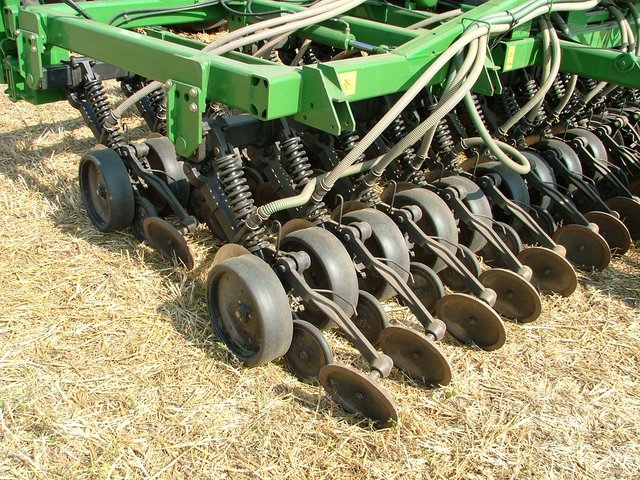
No-till agriculture [ฮังการี]
No-till agriculture replaces conventional soil tillage in order to reduce costs and labour - and to provide a mulch layer on the soil surface from the residues of the previous crop: this protects the soil surface and its ecology.
- ผู้รวบรวม: Brigitta Szabó
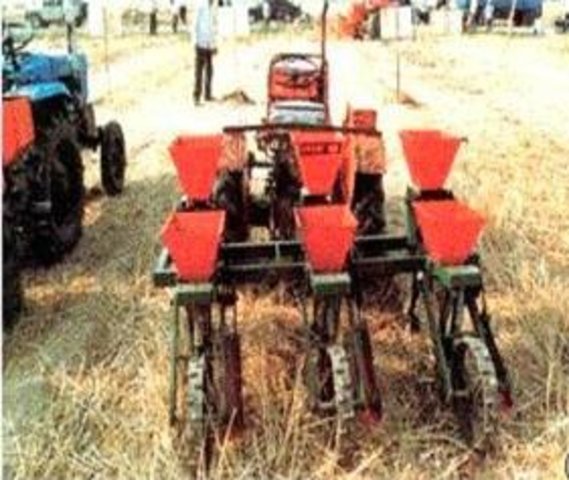
Zero Tillage [จีน]
Zero tillage technology was developed to protect the soils from sealing rainfall, to achieve and maintain a open internal soil structure, to enhance biological processes in the soil, and to develop a means for safe disposal of any surface runoff that nevertheless will occur.
- ผู้รวบรวม: Zhanguo Bai
2. คำอธิบายของแนวทาง SLM
2.1 การอธิบายแบบสั้น ๆ ของแนวทาง
Zero tillage approach was developed to protect the soils from sealing rainfall, to achieve and maintain a open internal soil structure, to enhance biological processes in the soil, and to develop a means for safe disposal of any surface runoff that nevertheless will occur.
2.2 การอธิบายอย่างละเอียดของแนวทาง
การอธิบายอย่างละเอียดของแนวทาง:
Sustainable agriculture in the dry and semidry regions in the north China, especially on the slope farmland is searching always based on the ecological balance. Conservative tillage such as zero, reduced and subsoiling tillage are important to keep soil fertility. Mulching is also a way to improve the soil organic matter. So no tillage with mulching is an approach to do this. No tillage lets all rainfall in the soils and avoid runoff occur.
2.3 รูปภาพของแนวทาง
2.5 ประเทศ ภูมิภาค หรือสถานที่ตั้งที่ได้นำแนวทางไปใช้
ประเทศ:
จีน
ภูมิภาค/รัฐ/จังหวัด: :
Henan province
Map
×2.6 วันที่เริ่มต้นและสิ้นสุดของแนวทาง
ระบุปีที่เริ่ม:
1995
การสิ้นสุดลง (ถ้าแนวทางไม่ได้ใช้อีกต่อไป):
2003
2.7 ประเภทของแนวทาง
- ใช้โครงงานหรือแผนงานเป็นฐาน
2.8 เป้าหมายหรือวัตถุประสงค์หลักของแนวทาง
The Approach focused mainly on SLM with other activities (Reduction of dust devil that occur in North China.)
The main objectives of the approach is to apply conservation tillage for sustainable agricultural development.
The SLM Approach addressed the following problems: Traditional tillage (multi-till) with little return of organic matters to soils results in soil fertility decline and nutrient loss as well as yield decrease. This approach is designed to change the traditional cultivation ways to conservation tillage.
2.9 เงื่อนไขที่เอื้ออำนวยหรือเป็นอุปสรรคต่อการนำเทคโนโลยีภายใต้แนวทางนี้ไปปฏิบัติใช้
การมีไว้ให้หรือการเข้าถึงแหล่งการเงินและบริการ
- เป็นอุปสรรค
buying no till machine and tractor
Treatment through the SLM Approach: subsidy and adjust crop planting pattern
กรอบแนวทางในการดำเนินการด้านกฎหมาย (การถือครองที่ดิน สิทธิในการใช้ที่ดินและน้ำ)
- เอื้ออำนวย
The existing land ownership, land use rights / water rights helped a little the approach implementation: Because land ownership belongs to state and land users can only lease land.
ความรู้เกี่ยวกับ SLM การเข้าถึงการสนับสนุนด้านเทคนิค
- เป็นอุปสรรค
organizing subdivided householders together
3. การมีส่วนร่วมและบทบาทของผู้มีส่วนได้ส่วนเสียที่เกี่ยวข้อง
3.1 ผู้มีส่วนได้ส่วนเสียที่เกี่ยวข้องในแนวทางนี้และบทบาท
- ผู้ใช้ที่ดินระดับท้องถิ่นหรือชุมชนระดับท้องถิ่น
Work equally divided between men and women (experimental areas selected on the basis of the landforms, contributed to diff, households). Householders organized by local committee or by implementation
- ผู้เชี่ยวชาญ SLM หรือที่ปรึกษาการเกษตร
- ครู เด็กนักเรียน หรือนักศึกษา
- รัฐบาลแห่งชาติ (ผู้วางแผน ผู้ทำการตัดสินใจ)
3.2 การเกี่ยวข้องของผู้ใช้ที่ดินระดับท้องถิ่นหรือชุมชนระดับท้องถิ่นในช่วงต่างๆของแนวทาง
| ความเกี่ยวข้องของผู้ใช้ที่ดินระดับท้องถิ่นหรือชุมชนระดับท้องถิ่น | ระบุผู้ที่มีส่วนเกี่ยวข้องและอธิบายกิจกรรม | |
|---|---|---|
| การริเริ่มหรือการจูงใจ | ไม่ลงมือ | Mainly:interviews/questionnaires; partly: public meetings; Generally local and/or village committee call land users who involved in the SWC project together and illustrate the purpose and obligation. |
| การวางแผน | จ่ายเงินหรือสนับสนุนจากภายนอก | rapid/participatory rural appraisal; Detailed planning are addressed to whose who take part in the activities. |
| การดำเนินการ | ปฏิสัมพันธ์ | responsibility for minor steps; Each step and procedures are guided and checked for implementation. |
| การติดตามตรวจสอบหรือการประเมินผล | ไม่ลงมือ | measurements/observations; Mainly done by the researchers and local government staffs not by local land users. |
| Research | ปฏิสัมพันธ์ | on-station; The effect and impacts of the SWC technology on the soil and environment are investigated and studied on experimental station and on farm. |
3.4 การตัดสินใจเลือกใช้เทคโนโลยี SLM
ระบุผู้ที่ทำการตัดสินใจเลือกเทคโนโลยีมากกว่าหนึ่งวิธีไปปฏิบัติใช้:
- นักการเมืองหรือผู้นำ
การอธิบาย:
Decisions on the choice of SLM Technology were made directive (top-down).
Decisions on the method of implementing the SLM Technology were made mainly by SLM specialists with consultation of land users.
4. การสนับสนุนด้านเทคนิค การสร้างขีดความสามารถ และการจัดการด้านความรู้
4.1 การสร้างขีดความสามารถ / การอบรม
ได้มีการจัดอบรมให้แก่ผู้ใช้ที่ดินหรือผู้มีส่วนได้ส่วนเสียคนอื่น ๆ หรือไม่:
ใช่
ให้ระบุว่าใครเป็นผู้ได้รับการอบรม:
- ผู้ใช้ที่ดิน
- SWC specialists, extensionists/trainers
รูปแบบการอบรม:
- เกษตรกรกับเกษตรกร
- ใช้พื้นที่ทำการสาธิต
- จัดการประชุมสู่สาธารณชน
- จัดคอร์ส
หัวข้อที่พูด:
Teaching them how to operate tractor/tillage with mulching residuals and fertilizing as well as seeding; to understand the importance of the roles of the SWC etc.
4.2 การบริการให้คำแนะนำ
ผู้ใช้ที่ดินมีการเข้าถึงการรับบริการให้คำปรึกษาหรือไม่:
ใช่
ระบุว่ามีบริการให้คำปรึกษาหรือไม่:
- ไปเยี่ยมชมสถานที่
การอธิบาย/แสดงความคิดเห็น:
Name of method used for advisory service: In situ demonstration and training; Key elements: Demonstration, Training, farmer visit; 1) Advisory service was carried out through: government's existing extension system, projects own extension structure and agents 2) Advisory service was carried out through: government's existing extension system, projects own extension structure and agents; Extension staff: mainly government employees 3) Target groups for extension: land users; Activities: Demonstration, training
Advisory service is quite adequate to ensure the continuation of land conservation activities; Top-down agricultural/SWC technology extension service system has been established at variable government levels, they have capability of extension all kinds of the new techniques.
4.3 การเสริมความแข็งแกร่งให้กับสถาบัน (การพัฒนาองค์กร)
สถาบันได้รับการจัดตั้งขึ้นมาหรือเสริมความแข็งแกร่งโดยแนวทางนี้หรือไม่:
- ใช่ อย่างมาก
ระบุระดับของสถาบันที่ได้รับการเสริมความแข็งแกร่งหรือจัดตั้งขึ้นมา:
- ท้องถิ่น
ระบุประเภทของการให้ความช่วยเหลือสนับสนุน:
- ด้านการเงิน
- การสร้างขีดความสามารถ / การอบรม
- อุปกรณ์
4.4 การติดตามตรวจสอบและประเมินผล
การติดตามตรวจสอบและประเมินผลเป็นส่วนหนึ่งของแนวทางหรือไม่:
ใช่
ความคิดเห็น:
bio-physical aspects were regular monitored through measurements
technical aspects were regular monitored through measurements
land users involved aspects were regular monitored through observations
There were few changes in the Approach as a result of monitoring and evaluation
4.5 การวิจัย
การวิจัยเป็นส่วนหนึ่งของแนวทางหรือไม่:
ใช่
ระบุหัวข้อเรื่อง:
- นิเวศวิทยา
- เทคโนโลยี
ให้ข้อมูลเพิ่มเติมและให้ระบุผู้ทำการวิจัย:
The successful results of the SWC study obtained by the SWC approach are widely applied to the control of the dust devil, and ecological recover. Research was carried out both on station and on-farm
5. การสนับสนุนด้านการเงินและวัสดุอุปกรณ์
5.1 ระบุงบประมาณประจำปีสำหรับแนวทาง SLM นี้
ถ้าหากว่างบประมาณประจำปีไม่เป็นที่ทราบแน่นอน ให้ระบุช่วงลงไป:
- 10,000-100,000
แสดงความคิดเห็น (แหล่งของการระดมทุน ผู้บริจาคคนสำคัญ):
Approach costs were met by the following donors: local community / land user(s) (National - Central government): 30.0%; government: 60.0%; international: 5.0%; other: 5.0%
5.3 เงินสนับสนุนสำหรับปัจจัยนำเข้า (รวมถึงแรงงาน)
- อุปกรณ์
| ระบุปัจจัยนำเข้าที่ได้รับการสนับสนุน | เห็นด้วยระดับไหน | ระบุเงินสนับสนุน |
|---|---|---|
| เครื่องจักร | ได้รับการช่วยเหลือทางการเงินบางส่วน | |
- การเกษตร
| ระบุปัจจัยนำเข้าที่ได้รับการสนับสนุน | เห็นด้วยระดับไหน | ระบุเงินสนับสนุน |
|---|---|---|
| ปุ๋ย | ได้รับการช่วยเหลือทางการเงินบางส่วน | |
- โครงสร้างพื้นฐาน
| ระบุปัจจัยนำเข้าที่ได้รับการสนับสนุน | เห็นด้วยระดับไหน | ระบุเงินสนับสนุน |
|---|---|---|
| community infrastructure | ได้รับการช่วยเหลือทางการเงินบางส่วน | |
ถ้าแรงงานโดยผู้ใช้ที่ดินเป็นปัจจัยนำเข้าที่มีอยู่มากมาย ระบุด้วยว่าเนื่องจาก:
- สมัครใจ
ความคิดเห็น:
Labour was voluntary, paid in cash and rewarded with other material support.
In the past (before 1980's), SWC activities are mainly done by community members through obligation. Nowadays under the conditions of economic market, people unwill to do this voluntary, they concern return of their input for SWC.
5.4 เครดิต
มีการจัดหาเครดิตมาให้ภายใต้แนวทาง SLM หรือไม่:
ใช่
ถ้าใช่ ระบุเงื่อนไข (อัตราดอกเบี้ย การชำระคืน):
Interest rate charged: 2.3%; repayment conditions: After 2 to 5 years when SWC produces benefits, loaner should repay.
Interest was lower than market rate.
6. การวิเคราะห์ผลกระทบและการสรุป
6.1 ผลกระทบของแนวทาง
ช่วยให้ผู้ใช้ที่ดินนำเอาเทคโนโลยี SLMไปใช้และบำรุงรักษาสภาพไว้ได้หรือไม่:
- ไม่ใช่
- ใช่ เล็กน้อย
- ใช่ ปานกลาง
- ใช่ อย่างมาก
Soil & water loss reduced much and soil fertility is greatly improved with increase in yield.
ปรับปรุงประเด็นของการถือครองที่ดินหรือสิทธิในการใช้ ซึ่งขัดขวางการนำเทคโนโลยีไปใช้ให้ดีขึ้น:
- ไม่ใช่
- ใช่ เล็กน้อย
- ใช่ ปานกลาง
- ใช่ อย่างมาก
Subdivision and lease of the land would hinder SWC implementation. The problem is likely to be overcome in the near future. Farmers worry that their land would transfer to others, well organizing could reduce the negative impact through prolong the lease period of land use.
Did other land users / projects adopt the Approach?
- ไม่ใช่
- ใช่ เล็กน้อย
- ใช่ ปานกลาง
- ใช่ อย่างมาก
6.3 ความยั่งยืนของกิจกรรมของแนวทาง
ผู้ใช้ที่ดินสามารถทำให้สิ่งต่างๆ ที่ได้ปฏิบัติใช้โดยแนวทางนี้ยั่งยืนได้หรือไม่ (โดยไม่มีการสนับสนุนจากภายนอก):
- ใช่
6.4 จุดแข็งและข้อได้เปรียบของแนวทาง
| จุดแข็ง / ข้อได้เปรียบของแนวทางในทัศนคติของผู้ใช้ที่ดิน |
|---|
| Raising yield and soil moisture as well as fertility. (How to sustain/ enhance this strength: Leaving high residual straw and cover soil surface.) |
| จุดแข็ง / ข้อได้เปรียบของแนวทางในทัศนคติของผู้รวบรวมหรือวิทยากรหลัก |
|---|
| Practical (How to sustain/ enhance this strength: Financial support from various government) |
| Very welcome by farmers. Great economic and ecological benefits (How to sustain/ enhance this strength: enlarging extension) |
6.5 จุดอ่อน / ข้อเสียเปรียบของแนวทางและวิธีในการแก้ไข
| จุดอ่อน / ข้อเสียเปรียบในทัศนคติของผู้ใช้ที่ดิน | สามารถแก้ไขปัญหาได้อย่างไร |
|---|---|
| Shortage of finance | Raising money |
| จุดอ่อน / ข้อเสียเปรียบในทัศนคติของผู้รวบรวมหรือวิทยากรหลัก | สามารถแก้ไขปัญหาได้อย่างไร |
|---|---|
| Hard to widely extension due to expensive tillage machinery | Government should financially support |
7. การอ้างอิงและการเชื่อมต่อ
7.1 วิธีการหรือแหล่งข้อมูล
- ไปเยี่ยมชมภาคสนาม การสำรวจพื้นที่ภาคสนาม
- การสัมภาษณ์กับผู้ใช้ที่ดิน
7.2 การอ้างอิงถึงสิ่งตีพิมพ์
ชื่อเรื่อง ผู้เขียน ปี ISBN:
Report of ninth-Five plan project on Dryland Farming, Jan 2002,
ช่องทางในการสืบค้น และราคา:
internal reference
ชื่อเรื่อง ผู้เขียน ปี ISBN:
Introduction of Luoayng physicography
ช่องทางในการสืบค้น และราคา:
unpublished materials
ชื่อเรื่อง ผู้เขียน ปี ISBN:
No-till farming for sustainable rural development, 2002
ช่องทางในการสืบค้น และราคา:
World Bank
ชื่อเรื่อง ผู้เขียน ปี ISBN:
A road map from conventional to no-till farming, 2002
ช่องทางในการสืบค้น และราคา:
World Bank
ชื่อเรื่อง ผู้เขียน ปี ISBN:
Conservation agriculture, 2001
ช่องทางในการสืบค้น และราคา:
FAO
ลิงก์และโมดูล
ขยายทั้งหมด ย่อทั้งหมดลิงก์

No-till agriculture [ฮังการี]
No-till agriculture replaces conventional soil tillage in order to reduce costs and labour - and to provide a mulch layer on the soil surface from the residues of the previous crop: this protects the soil surface and its ecology.
- ผู้รวบรวม: Brigitta Szabó

Zero Tillage [จีน]
Zero tillage technology was developed to protect the soils from sealing rainfall, to achieve and maintain a open internal soil structure, to enhance biological processes in the soil, and to develop a means for safe disposal of any surface runoff that nevertheless will occur.
- ผู้รวบรวม: Zhanguo Bai
โมดูล
ไม่มีโมดูล


